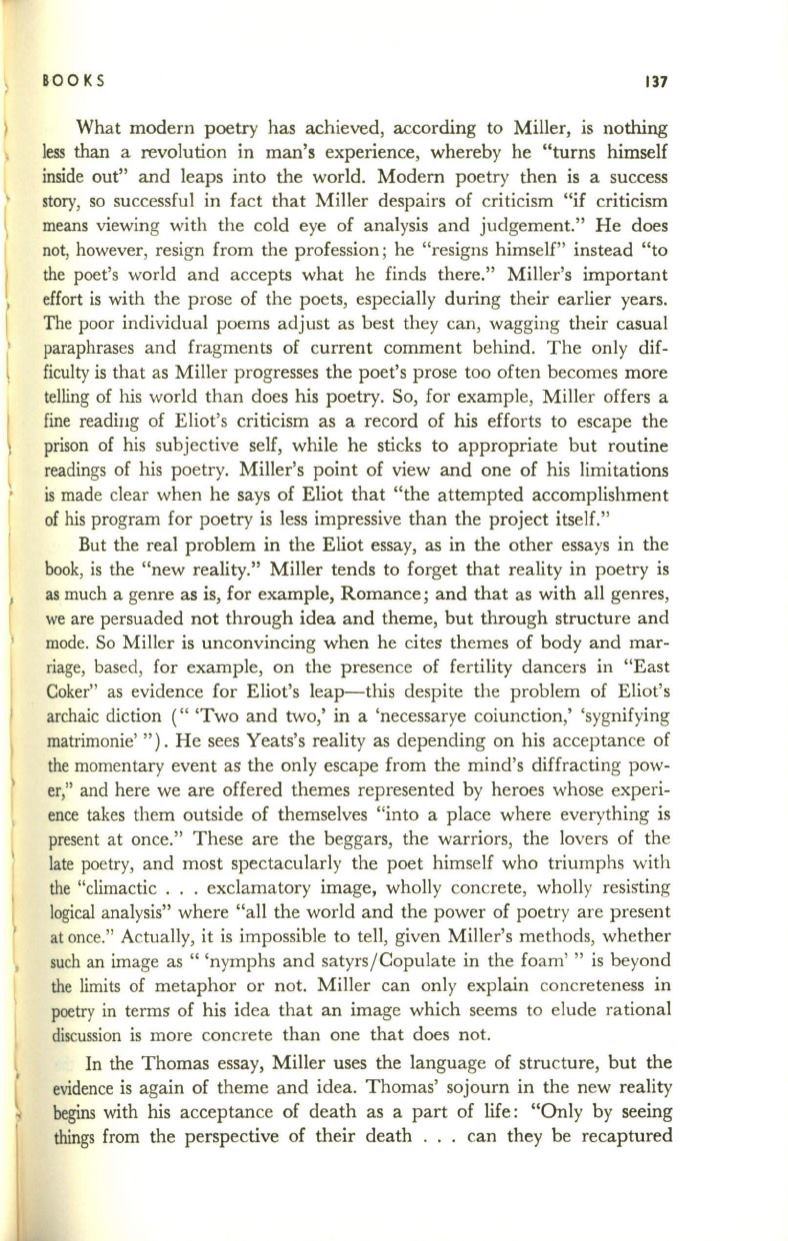
BOO KS
137
What modern poetry has achieved, according to Miller, is nothing
less than a revolution in man's experience, whereby he "turns himself
inside out" and leaps into the world. Modern poetry then is a success
story, so successful in fact that Miller despairs of criticism
"if
criticism
means viewing with the cold eye of analysis and judgement." He does
not, however, resign from the profession; he "resigns himself" instead "to
the poet's world and accepts what he finds there." Miller's important
effort is with the prose of the poets, especially during their earlier years.
The poor individual poems adjust as best they can, wagging their casual
paraphrases and fragments of current comment behind. The only dif–
ficulty is that as Miller progresses the poet's prose too often becomes more
telling of his world than does his poetry. So, for example, Miller offers a
fine readiug of Eliot's criticism as a record of his efforts to escape the
prison of his subjective self, while he sticks to appropriate but routine
readings of his poetry. Miller's point of view and one of his limitations
is
made clear when he says of Eliot that "the attempted accomplishment
of his program for poetry is less impressive than the project itself."
But the real problem in the Eliot essay, as in the other essays in the
book, is the "new reality." Miller tends to forget that reality in poetry is
as much a genre as is, for example, Romance; and that as with all genres,
we are persuaded not through idea and theme, but through structure and
mode. So Miller is unconvincing when he cites themes of body and mar–
riage, based, for example, on the presence of fertility dancers in "East
Coker" as evidence for Eliot's leap--this despite the problem of Eliot's
archaic diction (" 'Two and two,' in a 'necessarye coiunction,' 'sygnifying
matrimonie' "). He sees Yeats's reality as depending on his acceptance of
the momentary event as the only escape from the mind's diffracting pow–
er," and here we are offered themes represented by heroes whose experi–
ence takes them outside of themselves "into a place where everything is
present at once." These are the beggars, the warriors, the lovers of the
late poetry, and most spectacularly the poet himself who triumphs with
the "climactic . . . exclamatory image, wholly concrete, wholly resisting
logical analysis" where "all the world and the power of poetry are present
at once." Actually, it is impossible to tell, given Miller's methods, whether
such an image as " 'nymphs and satyrs/Copulate in the foam' " is beyond
the limits of metaphor or not. Miller can only explain concreteness in
poetry in terms of his idea that an image which seems to elude rational
discussion is more concrete than one that does not.
In the Thomas essay, Miller uses the language of structure, but the
evidence is again of theme and idea. Thomas' sojourn in the new reality
begins with his acceptance of death as a part of life: "Only by seeing
things from the perspective of their death . . . can they be recaptured


